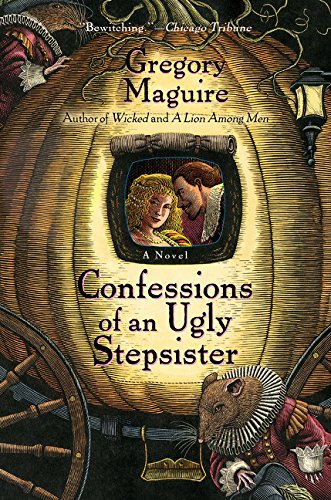A Fair Trade Book

Title: Confessions of an Ugly Stepsister
Author: Gregory Maguire
Author's web site: https://www.gregorymaguire.com/
Date: 1999
Publisher: Harper Collins
ISBN: 0-06-098752-9
Length: 368 pages
Illustrations: black-and-white woodcut-style pictures by Bill Sanderson
Quote: “Indeed, were Cinderling to return from the dead, would she even recognize herself?”
Retelling the Cinderella story as a realistic adult novel, Gregory Maguire shifts the focus to the stepsisters and gives the story a surprise ending. Which stepsister confesses to what is part of the surprise.
How can the Cinderella story be made realistic? Simple, once you’ve thought about it. You can’t have a dead mother returning in the form of a bird, or a pumpkin turning into a coach, in a realistic novel, but you can have a character who makes up that kind of stories in order to give answers that make it clear that she’s not about to tell the truth. That’s Maguire’s Cinderella: an habitual liar, to herself and others. Although Maguire carries the story forward through several years of realistically-happy-ever-after, the stepsisters to whom she writes and sends money know better than to take Cinderella’s stories literally.
He also gives readers a peek at an interesting part of European history. Seventeenth-century Holland was where a real prince was allowed to marry any commoner of his choice—because his family knew he couldn’t live long enough to be king, and were trying to marry him off with the promise that whoever took him would be a rich widow. It was a place where decent men like Cinderella’s stepfather lost fortunes by investing in what seemed like the profitable flower business, during “the tulip mania.” It was also the home of Judith Leyster, Rembrandt van Rijn, and a whole group of other painters whose work is still admired today. At this period all of Europe agreed that the Netherlands were interesting; so does Maguire, and so, for the duration of the novel, will readers.
Maguire gives the Thin Stepsister enough backbone to consider honest work as a way to restore the family fortune, and makes her a painter’s talented apprentice. One of the stepsisters will even live to see New Amsterdam. He also adds violence and gross-outs to what’s often told as a bland little fairy tale: there’s a witch hunt, a kidnapping, deaths from gruesome seventeenth-century diseases. We get some insights into the superstitions of seventeenth-century Europe and what they might originally have referred to, including the disfigured, disabled people who might have been seen as “imps” and “changelings.”
There is some talk about the moral beauty of charity in the story. There are many displays of moral ugliness. Each of the five female characters does at least one good thing and at least one terrible thing. All three sisters are PMS sufferers and are guaranteed to help readers appreciate their own sisters—whatever your sister’s shortcomings, she’s probably easier to live with than these girls. The mother and stepmother are also dysfunctional. Male characters are so consistently nicer than female characters, in this novel, that one begins to suspect that it was written during a divorce process.
Nevertheless, although the stepmother schemes to marry Cinderella to a variety of off-putting creditors if she can’t marry the Thin Stepsister to the prince, all three girls live more happily than they deserve ever after. It's a realistic novel and although the prologue states, as quoted, that Cinderella is already dead, she didn’t die young; neither did the stepsisters.
By and large Maguire pulls off the difficult trick of writing from an opposite-sex viewpoint. Like most men who’ve done this, he makes the task easier by taking the viewpoint of a woman who’s very discreet about any “romantic” feelings she may have. Most of the time it’s convincing, although, in a story where clothes matter as much as they do in the Cinderella story, and with a setting where the fashions were as odd and interesting as they were in seventeenth-century Holland, the stepsister’s lack of interest in the details of dresses is the kind of thing that reminds you that, oh right, in real life the writer's a man.
What’s not to love? Well, Maguire apparently has some issues with women, but that’s his problem. I find the publisher’s packaging of this book pretentious. It’s a well-written novel, but since when does a new novel require a study guide? However, I enjoyed the novel enough that I’m inclined to ignore the study guide.
If you’re interested in reading a Cinderella story that might have happened, as narrated by an elderly cynic with a mean sense of humor, Confessions of an Ugly Stepsister is for you. By now the author of Wicked probably doesn't need another dollar, because with a Disney contract his fortune should be made, but if you send $5 per copy + $5 per package to either address at the left side of the screen (above the ad), I'll send $1 to Maguire or a charity of his choice anyway.
(Wordpress tags: Disney movie “Wicked”,European history, Gregory Maguire, Holland in the 1600’s, retelling Cinderella story, seventeenth century Dutch painters.)
No comments:
Post a Comment